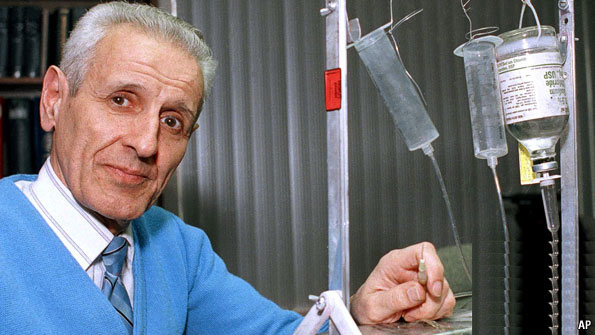Dr. Jack Kevorkian is the largest advocate of euthanasia in American history, and he began the widespread conversation about end of life options.
He’s known to have said “Dying is not a Crime,” and his advocacy led in part to Oregon’s passing of the Death with Dignity act, which made Oregon’s jurisdiction one of the first in the world that allows terminally ill patients to determine the time of their own death. In euthanasia, the attending doctor administers the final lethal dose. In PAS (physician-assisted suicide), the attending doctor merely provides the final lethal dose and the patient administers it (PAS is the one to have been recently legalized in California). It bears noting here that there are a number of terms associated with end of life rights, but we’ll deal with PAS primarily.

Jack Kevorkian was born Murad Kevorkian on May 26, 1928, in Pontiac, Michigan. Coming up in grade school, he read voraciously and was labeled as a bookworm, further complicating his friendships. At 17, he graduated from high school with honors.
He became Dr. Kevorkian while serving in the Korean War and grew fascinated with death after serving his residency in the 1950s. He soon after earned a negative reputation with many due to his pursuit of ideas generally regarded as distasteful. Such ideas got him ejected from University of Michigan despite any success of his experiments. His advocacy reached boiling point in 1998, when he allowed the CBS television news program 60 Minutes to air a tape he’d made of the lethal injection of Thomas Youk. Youk suffered from Lou Gehrig’s disease and had requested Kevorkian’s help, but Kevorkian was convicted of second-degree murder in 1999 in spite of Youk’s request. Kevorkian was released on good behavior in 2007, but was dying from liver damage and the advanced stages of Hepatitis C. In 2011, he died at the age of 83 in his home state of Michigan. But, unfortunately, he only passed after two weeks of suffering kidney and heart complications. He once said that his life work advocating PAS was not entirely unselfish—he would want access to this end of life option himself.
The first country to legalize euthanasia and PAS was the Netherlands. Though many countries either outlaw euthanasia in any form or only changed their laws on euthanasia in the last two decades, it has been a concern for Greek and Roman doctors since 500 BC.
But with respect to general opinion on euthanasia and PAS in other parts of the world, we should note that many cultures have no frame of reference for euthanasia and the ethics involved. The only places that have legalized euthanasia are the Netherlands, Belgium, Luxembourg, Ireland and Colombia. PAS is legal in Switzerland, Germany, Japan, Albania, Canada, and in the US states of Washington, Oregon, Vermont, New Mexico, Montana and, now, California.
In California, the End of Life Option act took effect on June 9, 2016 and current events have created some very mixed feelings.
Some feel relief, but others are livid. Sites like patientsrightscouncil.org may be host to arguments regarding the “truth” of euthanasia, but testimonials from patients like Brittany Maynard, a brain cancer patient who had to move states for treatment, convince me that groups like Patients Rights Council aren’t putting the patient first with their anti-euthanasia activism. PRC’s site doesn’t provide a forum for discussion on the ethics of expanding patient rights but suggests “essential reading for anyone who has misgivings about giving doctors the right to kill.”
PRC (formerly known as the “International Task Force on Euthanasia and Assisted Suicide”) seems to think this choice is about the decisions doctors make—this issue certainly involves doctors, but the term “end of life options” refers to the person whose life will end, and the main concern should be for the patient in question.
Yet, one can’t help but wonder: what of cases in which the patient fulfilled all requirements for assisted suicide, but was too weak to self-administer the final lethal dose? This requires a greater amount of the doctor’s agency—what’s the correct course of action in this case? The disability community fears the abuse of these new laws due to prejudice and bias against the parties in question. They claim that PAS are masked with the idea of ‘patient agency’ yet endanger people with disabilities due to a societal devaluation of disabled peoples’ lives.
Devaluation of life is an important thing to prevent, and we ought to ensure disadvantaged populations aren’t disproportionately affected by this call for death with dignity.
The Disability Rights Education and Defense fund discusses this here, saying that legalizing PAS would augment many dangers that negate genuine choice and self-determination. Regulation is no doubt important, however, the Disability Rights Education and Defense fund claims that “the number of people whose situations would actually be eligible for assisted suicide is extremely low[.]” Protection of the patient’s right to choose end of life options independently of the world’s wishes does not imply the “slippery slope” argument will hold water; and though the Netherlands’ euthanasia numbers were on the rise in 2014, only time will tell the benefits and detriments of these changes in legislation.

Click to read the full bill here
There is much criticism of PAS, but there is an undoubted demand for making PAS an accessible legal end of life option. Brittany Maynard was forced to relocate from California to Oregon at the end of her life, which meant she had to establish residency in Oregon, get a new driver’s license, search for a new home, change voter registration, find people to care for her animals, find new physicians, and her husband had to take a leave of absence from his job. Such major life changes force dying patients to use what little time, resources and flexibility they have left solving issues people shouldn’t have to deal with on their deathbeds. It seems that the most pertinent thing is to guarantee that physicians or designees assisting with the suicide are acting in the patient’s best interest and not abusing their capacity.
How do you feel about the issue? Is it an acceptable option because the patient gives an advance directive ordering the lethal action?
What about if the person hasn’t given an advance directive? The cases vary widely, and there will always be doctors who abuse the system, but we can’t let the abuse of these end of life options prevent us from giving agency to those victim to unimaginable suffering, despite whatever our understanding of their suffering may be. If you were denied agency over your body—a hotly debated issue that is similar: abortion and a woman’s right to make decisions about her own body—how would you venture to secure that agency? Would you want to uproot family and home just to find a place where you won’t force others to become criminals for helping you do what you know you cannot do alone? Who would this choice hurt besides the already suffering? And perhaps we’re looking at this from the wrong angle—perhaps decriminalization, not legalization, is the answer here. We mustn’t forget—we are all terminal.



